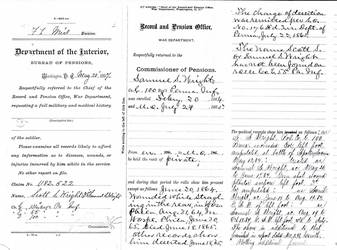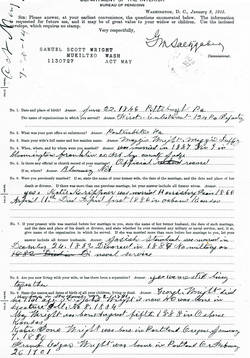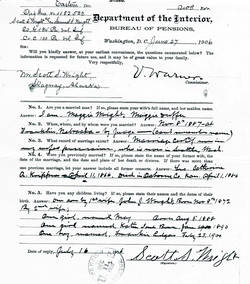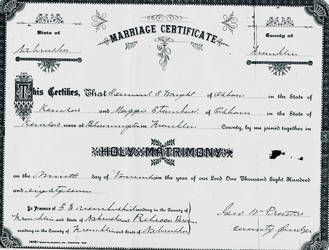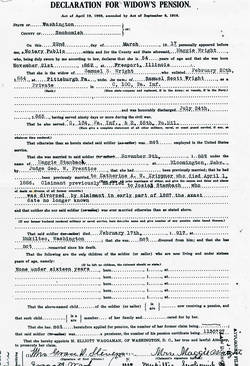Samuel Scott Wright
Representing: Union
G.A.R Post
- John Buford Post #89 Everett, Snohomish Co. WA
Unit History
- 134th Pennsylvania Infantry G
- 55th Pennsylvania Infantry E
- 100th Pennsylvania Infantry C
Full Unit History
134th PENNSYLVANIA VOLUNTEER INFANTRY
Organized: 7/62 Camp Curtin, Harrisburg, PA
Mustered In: 8/62 Camp Curtin, Harrisburg, PA
Mustered Out: 5/26/63 Harrisburg, PA
55th PENNSYLVANIA VOLUNTEER INFANTRY
Organized: 6/27/63:
Mustered Out: 8/26/63
100th PENNSYLVANIA VOLUNTEER INFANTRY
Organized: August, 1861 Southwestern PA
Mustered In: 8/31/61
Mustered Out: 7/24/64 Washington, D.C.
Regimental History
REGIMENTAL HISTORY: 134th
* NOTE: Service in this regiment was under the name Scott S. Wright
The 134th, an "eastern theater" Army of The Potomac regiment, was recruited under U.S. President Abraham Lincoln's 7/62 call for volunteers and sworn into Federal service for a period of 9 months. Because of the enemy's movement upon Washington City the 134th departed Pennsylvania for that location on 8/20, even before all companies had received Federal muster. Further, few officers or men of the unit had prior military experience.
The 134th arrived in Washington too late to participate in either the 2nd battle of Bull Run/Manassas, VA (8/ 28-30/1862) or Antietam/Sharpsburg, MD (7/16-18/1862). It camped near Antietam creek until the end of October and ended the year at the battle of Fredericksburg where it on the right of the first line in the final charge upon the stone wall below Marye's Heights, VA. There the regiment lost 14 killed, 106 wounded and 19 missing. It had "seen the elephant" in a "big" way.....
Except for Union Gen. Ambrose E. Burnside's abortive January, 1863 "mud march", the 134th remained in winter camp until late April, 1863 when it entered the Chancellorsville, VA Campaign. It was active on 5/2/1863, the third day of the battle after which the campaign was named and was highly commended for its actions. Those commendable actions cost the regiment 48 killed, wounded and missing.
Soon after Chancellorsville the 134th returned to Harrisburg for final muster. Although in the service of the U.S. a relatively short period of time, the regiment had fought in two of the War's major battle and, as a result had suffered significant casualties: Officers killed/mortally wounded = 4, Officers died of disease, accidents, etc. = 1; Enlisted men killed/mortally wounded = 38; enlisted men died of disease accidents, etc. = 66.
REGIMENTAL HISTORY: 55th
In June, 1863 rumors were constantly afloat about Confederate forces invading Border States of the north, including Pennsylvania. In response to these rumors two new regional departments - the Monongahela and the Susquehanna - were established and the call went out for volunteers to man short term, "emergency" regiments. As a response to this eight regiments: the 20th, 26th, 27th, 28th, 29th, 30th, 30th and 31st were federally mustered and fielded.
Once the Rebels crossed the Potomac another proclamation was issued by Pennsylvania's Governor Curtin calling for an additional 60,000 men to be mustered into "State" service for a period of 90 days and discharged as soon as the "danger" was over. From this call came twenty eight "militia" regiments, including the 55th.
None of the militia regiments participated in the battle of Gettysburg, although some joined the Army of the Potomac in Maryland afterwards. For the most part it appears these regiments preformed various duties within the State of Pennsylvania such as preserving order at Gettysburg and Philadelphia and other "valuable services." Exactly what "services" the 55th provided during its brief tenure with Wilkinson's Separate Brigade in the Department of West Virginia is not known. The unit apparently suffered no deaths.
REGIMENTAL HISTORY: (100th)
The 100th, a three year unit known as the "Round Head" regiment was raised in southwestern Pennsylvania. Unlike most, it was to serve in the War's eastern and western theaters. On 8/20/61 it was ordered to Washington City where its organization was completed and it was mustered into Federal service.
The regiment was next ordered to Fortress Monroe, VA and from there moved with the Union amphibious expedition south to Port Royal, SC where, in November it aided in the capture of Forts Walker and Beauregard. It next occupied Beaufort where it remained for several months suffering mightily from sickness, the northerners being unused to the warmer southern climes. It next participated in the 6/62 operations against Charleston, SC and Secessionville. In the latter the 100th lost heavily. In July the regiment was ordered back north to Virginia.
In 8/62 the unit again met the enemy at the battle of 2nd Bull Run/Manassas where it saw hard service. After being engaged all day and losing heavily it was ordered to make a final charge from which only 198 out of 450 men returned unhurt. Immediately thereafter the 100th saw combat at Chantilly, VA and South Mtn., MD, but was held in reserve at Antietam/Sharpsburg because of its crippled condition. It concluded the calendar and combat year at Fredericksburg, VA where, after the battle it covered the withdrawal of Federal forces back across the Rappahannock River. For their duties at Fredericksburg the Round Heads were named the most reliable skirmish regiment of their brigade.
March, 1863 saw the 100th transferred from the east to Lexington, KY in the west. From there the unit joined the forces of Union Gen. U.S. Grant moving toward the 7/4/63 capture of Vicksburg, MS. During this period the regiment lost as many men from sickness as it did from enemy fire. It was next ordered to East Tennessee though many of the men were not fit for active service. The hardships of the Knoxville siege did not help regimental health. Still, despite hardships the entire regiment re-enlisted on 1/1/64.
Re-enlistment/veteran furloughs behind them, the men of the 100th joined the Army of the Potomac in March. What followed was the Overland Campaign southward through VA which began in early May and took the regiment through The Wilderness, Spotsylvania, the North Anna River and Cold Harbor. Moving to the investment of Petersburg the 100th was repeatedly in action, notably at the explosion of "the mine", the raid on Weldon RR, Poplar Spring Church, the Hatcher's run movements and the 4/2/65 final assault on Petersburg. .
The regiment was mustered out 7/24/65 at Washington City with a loss record as follows: 16 officers killed or mortally wounded; 2 officers died of disease, accidents, etc; 208 enlisted men killed or mortally wounded, and 183 enlisted men died of disease, accidents, etc.
Soldier History
SOLDIER: (134th)
Residence: Portersville, PA Age: 16.2yrs.
Enlisted/Enrolled: 8/12 or 16/62 Portersville, Butler Co., PA Rank: Pvt.
Mustered In: 8/12 or 16/62
Discharged: 2/12/63 in camp near Falmouth, VA
Highest Rank: Pvt.
SOLDIER: (55th)
Residence: Portersville, PA Age: 17.0 yrs.
Enlisted Enrolled: 6/27/63 Rank: Pvt.
Mustered In: 6/27/63
Mustered Out: 8/26/63
Highest Rank: Pvt.
SOLDIER: (100th)
Residence: Inf. Not Avail. Age: 17.7 yrs.
Enlisted/Drafted: 2/20/64 Rank: Pvt.
Mustered IN: 2/20/64
Mustered Out: 7/24/65
Highest Rank: Pvt.
Family History
PERSONAL/FAMILY HISTORY:
Information on the life Samuel Scott Wright is, at its worst, scarce, and at best, murky. To begin with, even his birth year is not definitive. One source points toward 1846, another indicates 1847 while a third fingers 1849. For our purposes, we will be using 1846 with the date and month being June 22nd.
The place of Samuel's entering the world was reportedly the Alleghany County portion of Pittsburg, PA. Beyond this, no documentation is available pertaining to his birth parents or nuclear family composition.
Definitive data on Samuel first appears in the 1860 U.S. Census for the community of Worth, Butler County, PA near Pittsburg. At that time he was noted as living with sixty-seven year old, William Moore and his family. Mr. Moore was a farmer, so perhaps Samuel was living with them as a teenaged farm hand.
In August, 1862 the 5'6", light complexioned, blue eyed Samuel, who apparently had no occupation at the time, enlisted in the U.S. Army. The fact that at sixteen, he was well under the legal enlistment age likely explains why the enrollment was made under the alias Scott S. Wright.
As with many who left life on the farm or in other venues of the time, the experience of being in close quarters with many other individuals and exposed to unfamiliar health environments, military life for private Wright proved to be a medical nightmare. In late 1862 while stationed at Sharpsburg/Antietam, Maryland soldier Scott came down with camp diarrhea which soon became chronic. He was soon hospitalized being emaciated, wracked with fever and generally disabled. After sixty days, he was declared unfit for the duties of a soldier and, since he would not likely be so until his term of enlistment had expired, given a medical discharge. Noted on his discharge paperwork, likely by a surgeon was the following: "This lad is not 17 years old."
Army life behind him, Samuel returned to Portersville, but did not remain there long. Apparently having regained his health, in late June, 1863 he again, only this time under his true name, entered the army. On this second occasion his brief term of service was apparently benign.
In February, 1864 Samuel entered the U.S. Army for the third, and final, time. While one source indicates he again volunteered, most likely on this occasion he was drafted. One may ask, "Having already served twice, why was he draft eligible?" Likely the answer is that his first enlistment was under a false name, so he wasn't credited with time-served by the Federal government. Further, his second enlistment was "state-only" and did not last for at least ninety days, so did not count as a completed period of Federal service.
During Private Wright's third incarnation as a Union Soldier he was faced with more hazardous circumstances than in the past. On 5/12/64, during Union actions around Spotsylvania Court House, VA while straggling from his unit he received a gunshot wound in the left foot. The wound subsequently resulted in the amputation of that appendage's third toe.
On 8/31/64 Private Wright was noted as being hospitalized in Philadelphia, PA. Although this stay carried the notation of "no diagnosis", it was likely because of the wound/amputation as when he returned to duty on 10/18/64 it was under the notation "always present except during wounding period."
In April/May of 1865 the War of the Rebellion came to an end. Here is where Private Wright's military status becomes cloudy. On 6/18/65 one documental notation was that he had died while hospitalized. Another indicated he had deserted on the same date, while a third listed him hospitalized as of 6/30/65. Perhaps he had deserted from the hospital, but with the War over, it was apparently "forgive and forget" as on 7/22/65 by special order of the Department of Pennsylvania the charge of desertion was remitted. Two days later, Samuel S. Wright returned to civilian life, settling in Harrisburg, PA to perform farm work.
The next documented entry for Samuel is on 4/11/66 when he married Catherine A. “Katie” Krippner. (b. 1847 PA) in Harrisburg, PA. The next noted move for Samuel is in 1867 when he and his wife moved to Reading, PA.
What happened to the family following the Reading move is not known as the Wrights' next documentation is from 1871 when they were in St. Louis, MO. It was there, that their first child, son George (5/2/71/MO) was born. The union would produce two additional children: a second son named John (b. 11/8/74 IL) and a third, William C. (b. l886 KS).
To describe the Wright's life following their settling in St. Louis is to chronicle a series of moves. In 1871 they were in Missouri, but during the same year moved to Springfield, IL. 1872 found them back in St. Louis while two years later they were in the city of Osborne, Nebraska.
The Wrights are not found in the 1880 U. S. Census, but available documentation places them in Portland, Oregon that year. Why the move westward was made is not known.
In 1886 Katherine/Catherine died in Osborn, KS. While the cause of her passing is not documented, very likely it was connected to childbirth complications as this was the same year and state in which son William C. came into the world.
On 11/9/87 in Bloomington, Franklin County, NB Samuel remarried to Maggie Stambach (nee Duffy b. 11/21/6l or 62). She had been previously married to Joseph Stambach from whom she divorced earlier that same year. Samuel and Maggie first child, Maggie May (b. 8/5/1888 KS was born nine months later. In addition to May, the second Mrs. Wright would bear two more children: Kate A. (b. 1/7/90 Portland, OR) and Frank Edgar (b.2/26/01 OR).
As evidenced by their children’s' birthplaces, the Samuel and Maggie began moving westward shortly after the birth of their first child. While there is no available census information for 1890, Katie's birth that year places them in the Pacific Northwest city of Portland, OR where they had apparently moved after leaving Kansas.
In February, 1898 Samuel left Portland to head northward to Skagway, Alaska. Whether or not he went seeking gold is not known, but '98 was the year of the Alaska Gold Rush. Whatever his motivation, he obviously did not abandon his family as he returned south at least long enough to father son Frank, later returning to Skagway with his family. In 1906 the Wrights were still in Alaska. At that time documentation noted the 5'8", 150 lb., blue eyed, light haired and florid complexioned Samuel was working in a Skagway sawmill. By 1910, however, he and his family (Maggie, Kate and Frank) had moved back southward to the western Washington State Snohomish County community of Mukilteo where he was engaged in farming.
Although Samuel Scott Wright had moved many times during his life, the move to Mukilteo was to be his last. He died there 2/17/17 and was buried in Evergreen Cemetery in the nearby Snohomish County City of Everett. At death he was receiving a $24 per month U.S. Government pension stipend based on ailments which traced back to his Civil War soldiering.
The census for 1920 placed fifty-seven year old Maggie in the Kitsap County, western Washington state community of Retsil residing in that community's veteran's home. While nothing can be found concerning her in 1930, she was likely still in Retsil as it was there she died in 1939. Her remains were then transported to Everett and were buried beside those of Samuel.
Cemetery
Buried at Evergreen Cemetery Everett
Row: 31
Site: 66
Adopt-a-Vet Sponsor
Robert Gordon
Bothell, WA


